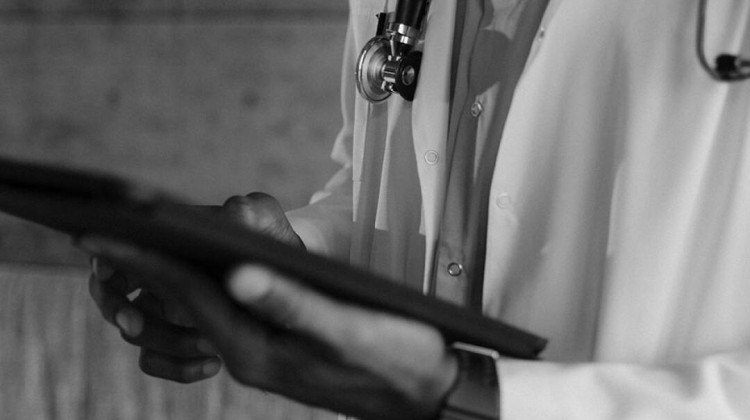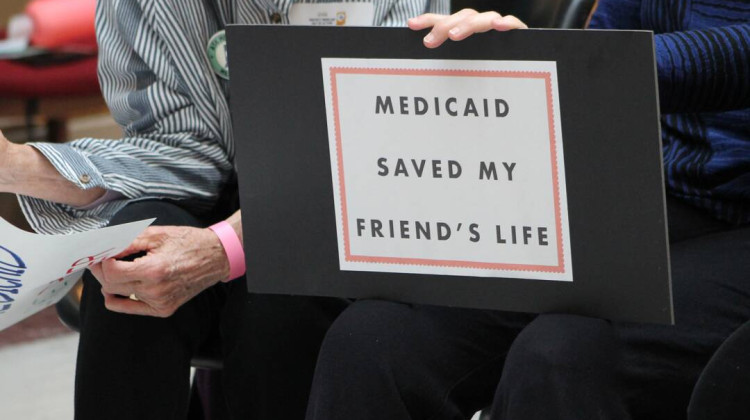In many ways, Violet Hall is an average 9-year-old. She’s goofy, smart, artistic.
But there’s something that makes Violet unique: she was born without her right hand or forearm.
She’s used prosthetics before, but she outgrows them quickly. They can also be clunky, bulky and expensive. But the one she’s using now is different.
Jon Racek is a senior lecturer of design in the Indiana University School of Art and Design. Racek made Violet a prosthetic using a 3-D printer in IU’s Mad Lab on campus.
“It’s just a series of slices and you can control that resolution, you can control how thick, how solid the pieces are,” Racek says, explaining how a 3-D printer works. “So if you were printing a cup, you would print a circle, and then the bed would drop by less than millimeters. Then you would print another circle, then it would keep going and keep going until you had a physical object.”

After attending an IU science festival, Violet’s mom Milet Hall posted on Facebook inquiring about 3-D printing. She wondered whether someone could print a prosthetic hand, custom fit for Violet. Racek’s daughters and Violet played on a sport’s team together. He saw the post and responded.
“It never even came up, so it’s just amazing that someone in our own back yard can help us out with something like that,” Hall says.
“I was really excited about the project,” Racek says. “I love this kind of work.”
It took about six months for Racek to make two prototypes and the final arm, but he says after this experience, he could do it much faster now. He printed the arm in a series of parts, then used what’s essentially fishing line to hold it all together.
“The way it works is when she bends her elbow, it moves the finger,” Racek says. “It’s not perfect, but you can get the sense of how it works.”
And Violet admits she’s still working out some kinks herself.
“Yeah, it’s very noisy,” she says. “I was really excited when I saw it because I didn’t know what it would be like to pick things up with my right arm and have fingers that can open and close on this arm.”

Violet uses her new prosthetic to pick up a water bottle. Photo: Steve Burns/WTIU
The big plus for the Hall family is that it was also affordable. Racek says the prosthetic cost only $35 to print.
“Part of the motivation behind this whole movement was prosthetics are very expensive and they’re very expensive for kids, and kids grow obviously,” Racek says. “As kids grow, you can reprint the arm to fit them.”
3-D printers are a game changer across the medical field, and not just with prosthetic arms.
Dr. Todd Midla is one the few orthopedic surgeons in the state, and the only one in Indianapolis, offering 3-D printed knee replacements. He says traditional knee replacements are based on a sized scale. That’s why 3-D technology makes more sense to him.
“When that prosthesis is made, it’s made to fit that patient only and nobody else,” Midla says.

Dr. Todd Midla is one of the few orthopedic surgeons in the state, and the only one in Indianapolis offering 3-D printed knee replacements. Photo: Becca Costello/WTIU.
Midla now recommends 3-D replacements for most of his patients. That’s a pretty dramatic shift considering he only began using the technology within the last two years. But he’s noticed faster recovery times and more satisfied patients.
Across the county doctors are using 3-D printers to make skin, synthetic organs, heart valves and medical devices. However, Midla acknowledges some doctors are apprehensive about using the technology because it’s still relatively new.
“I think as they see that data and patients coming in wanting it, they’re going to be forced to at least look at it,” Midla says.
Working with Violet is one of Racek’s first forays into medically-related 3-D printing.
“She had some interest in playing violin, so what I’m working on now is an attachment that will allow her to hold a bow,” Racek says.
Looking to the future, he sees incredible potential for 3-D technology.
“I think the way you proceed is you get a lot of people at the table, you get doctors, you get nurses… you get designers, you get fabricators, and with all that input, you’re going to get good solutions that work,” Racek says.
Racek is also working on several 3-D printing projects internationally, like another prosthetic arm for a little girl in Uganda.
Worldwide interest in 3-D printing is gaining momentum. A recent report projects the 3-D bio-printing industry will reach a value of $1.8 billion by 2027.
 DONATE
DONATE










 Support WFYI. We can't do it without you.
Support WFYI. We can't do it without you.